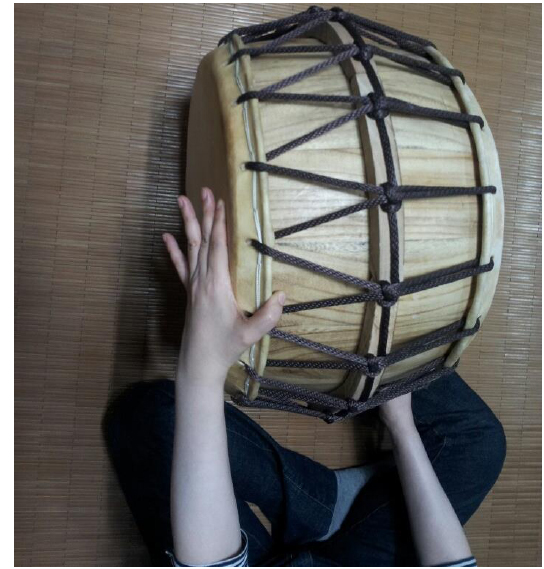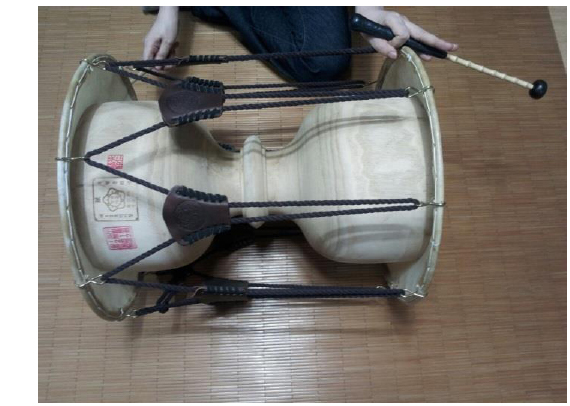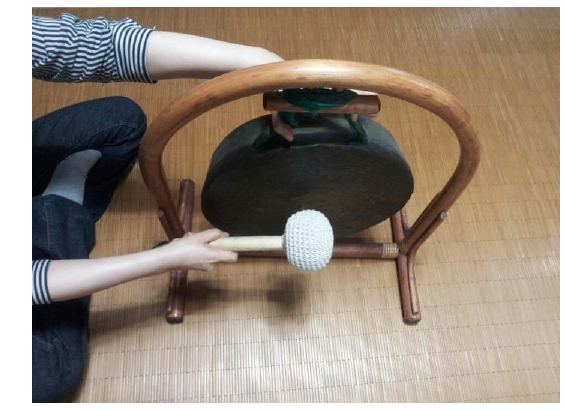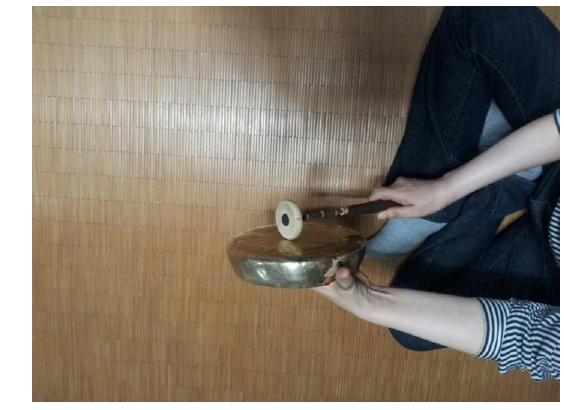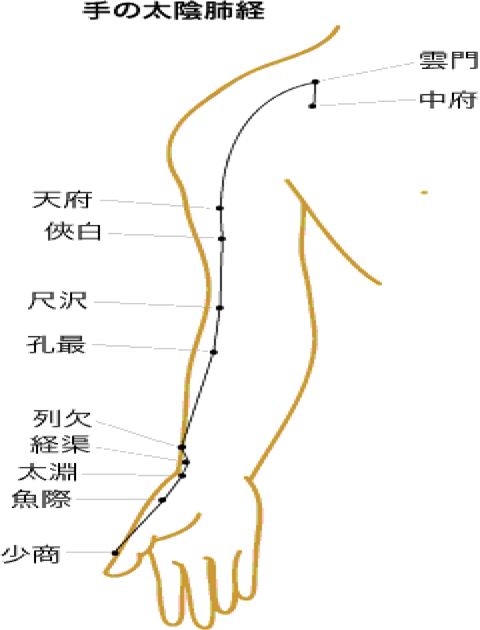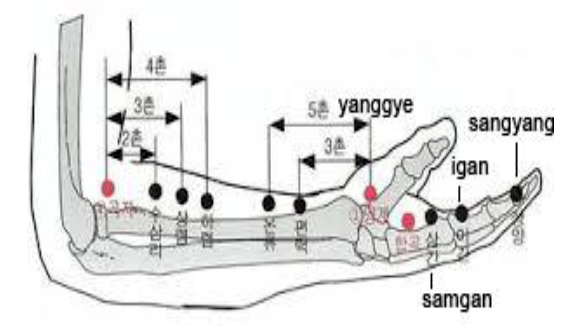



Samulnnori is one of the most popular music programs in adult education in South Korea. Samulnori is an ensemble of four percussion instruments. It is small and large gong, barrel and hourglass drums are used. In other words, ‘four things play’ including Kkwaengwari or soe (small hand-held gong) (Hesselink, 2004), Jing (large hand-held gong) (Hesselink, 2004), Janggu (hourglass-shaped drum) (Hesselink, 2004), and Buk (barrel-shaped drum) (Hesselink, 2004). It has uniquely combined urban and rural, eastern and western musical traditions synthesized in music. This combination gives Samulnori its unique sound. Listening to music is a complex phenomenon, involving psychological, emotional, neurological, and cardiovascular changes and behavioral modifications of breathing (Shea, 1996). In Eastern music, rhythm is metro rhythmic, meaning it is inseparable from the melody (Gilad, 2010). There are four instruments for Samulnori.
The Buk (Fig. 1) is a Korean traditional drum with a body shaped like a barrel. The body is generally made of wood which were mainly poplar and paulownia. It is 60 cm in diameter and 30 cm long. It is typically made by attaching cow and horse skin on either side. Listening to music requires both the female and male of cow to sound properly. It was based on the yin and yang principle of oriental philosophy. Koreans thought the healthy music of euphony depends on the harmony of yin and yang. This movement is played at an exciting tempo. It holds a birchen stick in right or left hand. The Buk is a barrel-shaped drum that is connected to the sound movements made from clouds. A floating clouds means freedom, which helps the listener feel as if he or she is flying in the sky without any restriction. Buk’s role is to emphasize stressed beats (Keith, 1988). Korean drum, Buk, made of natural materials of simple designs, highlight the pureness of nature and portray the aesthetic sense of the traditional instrument style.
Janggu and Janggo (or changgo, chang = stick; -go = drum, or Jang = deer; -gu= dog, Fig. 2) is a double-headed drum with a body shaped like an hourglass. It is used the most widely among all Korean instruments. It accompanies vocal music such as sanjo (sung three line poems), kagok (lyric songs), and many minyo (folksongs), is essential to every contemporary school of sanjo (literally, “scattered melodies” for solo instrument and drum), and is found in many shaman ceremonial and court ensembles. Wooden bodies are usually turned from a single section of paulownia (odong namu) trunk and consist of two bowls, one slightly larger than the other, connected by a hollow waist (Keith, 1988). One stick (yol ch’ae) and the palm of the hand or two sticks (yol ch’ae and k’ung ch’ae) are used to strike it (Keith, 1988). The right and left two skins of Janggu are made of deer and dog-skin. Right and left represent the harmony of yin and yang, which is the origin of all things in the universe. Today, deer skin is expensive and consequently rare. So, cowskin, goatskin, and dogskin are more frequently used. In pitch by an octave, Janggu skins are used differently. The cowskin and dogskin have different timbres. Most frequently, dogskin are used on the right, cowskin on the left. The dogskin has a clear sound, while the cowskin has a soft sound. The cowskin creates a soothing tune and rhythm, and the dogskin creates elegant tunes and rhythms. These tunes and rhythms produce an impression of a sprinkling rain.
The history of Jing or Ching (Fig. 3) goes way back to the previous Goryeo Dynasty (918-1392) in Korean peninsula. If we strike the Jing, a great sound crashes out. This is how the instrument got, nickname of ‘big brass.’ Also, it is named ‘gochuiching (means that sound gains in strength)’ in military music. Especially, it makes a long echoing and a dim sound. It would seem unimportant as an insignificant music instrument in Samulnori. But, Jing plays important role such as the head of a family. It should take control of tuning, although, it embraces off beat. Jing cannot be too underlying about formation of rapture in Samulnori. Jing is made of round, thick, and a brass panels. It is approximately 60 cm in diameter and 10 cm width of round. After drilling two holes around the instrument, a string is tied. The length of ‘jingchae (a kind of drumstick)’ is nearly 20 cm and is made of wood.
>
Kkwaengwari or soe (small hand-held gong)
Match for thunder is Kkwaengwari (Fig. 4). Kkaenggwari plays an important part in leading the Samulnori performance. The musician of this instrument is often responsible for creating waves of harmony for the rest to follow. It is made out of brass and it is thin and round. More importantly, a metallic sound is a sense of leadership unique in the music world today. It makes high-pitched sounds. Their tones are produced by the vibration of the metals and are controlled by the left hand. For this reason, Kkaenggwari players are often at the head of role playing Samulnori, signaling changes in the rhythm or volume of the music. It is approximately 20 cm in diameter and 4 - 6 cm width of round. After drill two holes in this round, tie a string. The length of a drumstick is nearly 20 cm and made out of a root of thin bamboo plants, then, hang a sliding into a round wood or a rubber in an edge of drumstick. Hang a piece of five colors cloth that is named ‘neoseol (a kind of decoration).’ from the end of a drumstick. At this time, five colors symbolize the directions and being different by the principles of yin/yang and five elements according to “East-West Encounters in the Nanjang: The Sound World of SamulNori and Red Sun Group”. This drumstick plays different functions one is playable and the other is danceable. A leading gong-player conducts Kkaenggwari with left hand and takes a drumstick and beat with right hand. At this time, left fingers are put into the back of Kkaenggwari and adjust the timbre and pitch. In essence, it plays an important part (leading sound) in Samulnori.
Music has stood at the center of human cure throughout human history. In the preface to the Akhak kwebeom that is called a canon of Korean music, and Guide to the Study of Music of 1493 is the culmination of fifteenth-century Korean Musical research and sets the standard to which court musicians have referred ever since (Robert, 1992), it says, “Music’s birth is in nothingness (this nothingness being that from which the universe finds origin) and it forms within nature: because of this, it causes deep emotion in man’s mind, mutual understanding and sympathy in his spirit, and emotional vitality in his life.” This well expresses Korean musical philosophy (Hwang, 1978). Samulnori represents that people are part of nature and should be in harmony with nature. They are usually unpitched in tone, but have an ideal harmony of nature and man. As it is capable of using both hands with equal ease, bring into balance yin and yang. The four instruments are subtly toned in with each other. Also, it stands for the harmony in the universe. These represent the four elements or nature, being cloud, rain, wind and lighting, as well as the harmony of wood, leather, metal, and balance. In Samulnori, cooperation and harmony are the most important objectives, not individualism. Needless to say, the rhythm is also essentially woven into the main fabric of the Korean music, as if it were a melodic instrument. Traditional healing teaches people that balance heals the body. In June 2004, two Korean scientists, Son and Bae found that the formant frequencies of instruments of Samulnori are a lot like the voices of young men and women (Table. 1). A formant is a peak in the frequency spectrum of a sound caused by acoustic resonance. This is perhaps why we find Samulnori sound so tempting. Kwaengwari has formant frequency that is similar to that of soprano. The formant frequencies of Jing, Janggu, and Buk are similar to those of tenor, alto, and baritone.
[Table 1.] Compare frequency instruments of Samulnori and voices of men
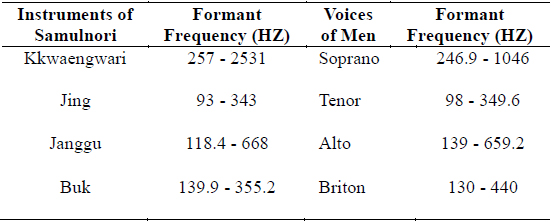
Compare frequency instruments of Samulnori and voices of men
The contents of Samulnori are consisted of factors of training of mind and an expressive sensibility with abdominal breathing and rhythms. Samulnori has developed an entertainment expression in the emotions of general public. The root of Samulnori lies in a robust itinerant performance troupe culture during the eighteenth and nineteenth centuries, a culture that shaped, through innovation, remodeling, and juxtaposition, much of what is considered traditional Korean folk music today (Song, 2001). Samulnori’s methodology and message is one of integration, on many different levels: mathematics, music theory, performance practice, and cosmology; humanity and its natural surroundings; the past and the present (and future); and Samulnori and the rest of the world. It is also about teaching the deepest, moral sense of the practice and profession. Samulnori that is getting into public favor until now undoubtedly represents the essence of peculiar Korean culture. In addition, in Samulnori the quartet starts much slower, at 84 to the dotted quarter, rapidly increases in tempo to a constant 120 in ‘three strokes’ (Hesselink, 2004). It required to use ten fingers actively, especially, thumb and index finger with abdominal breathing. Samulnori should match a rhythm with abdominal breathing. Music instrument is one of the nonverbal tools for communication. It can communicate user’s ideas and feelings by means of combination of a variety of styles of music instruments. That is why it is used a good cure for venting a manifestation of emotion and had an effect on the state of mind. Also, learning to play a musical instrument is fun and good for your mind and promotes social skills and cohesion. Moreover, it could be considered one of the most and fulfilling experiences one can aspire. Music is an intrinsic part of human existence, i.e. in terms of responses such as pulse, rhythm, breathing and movement, and the whole range of emotions according to music therapy of Boxill.
Playing percussion that is consisted of combination of rhythm causes physical reactions (Robb, 2003). By the auditory and tactile percussion is a combination of physical energy and act as cause emotional responses. In 1968, Gaston states, as music and human development are closely related, the important element of the rhythm of the music gives a very big impact on the human development. 3 patients (female: 2 persons, male: 1 person) who are taken to rehabilitation clinic in H hospital after they were diagnosis as hemiplegia due to stroke. In 2010, according to Nam, the therapeutic instrumental music playing helped the upper limb function of patients’ and their activities of daily living. In 2011, according to Lee, playing percussion program showed statistically meaningful results (
In this way, Samulnori and percussion activity have had positive psychological and physical impact on child and seniors, but there is still no research on liver cirrhosis. According to Korean mortality is the mortality from liver cancer in 2013. But statistics of Korean Life Assurance Association, the top of liver cirrhosis is just as dangerous as liver cancer. A variety of a articles reviewed revealed that Samulnori was helpful to the patient in a wide array. However, on liver cirrhosis, it is not clear. Here’s the author’s report that experience of Samulnori plays a significant role in improvement of liver cirrhosis. It is need for using ten fingers actively, especially, a thumb and an index finger, with abdominal breathing. Samulnori’s percussions are held by hand and stuck by a bamboo mallet, especially, strain a thumb and an index finger muscle. Korean medicine takes using a thumb muscle as an activity that makes the lung healthy (Table 1). Also, according to the principle of the viscera relationship, the large intestine and the liver get along very well each other (Table 2). A meridian is the most sensitive a spot where we broke out in the body and passage of energy flows a lot. Lung meridians are from axillary to toe of thumb. Lung meridians are ruled in improvement of lung. A healthful lung makes to be sound liver. According to Yellow Emperor’s Inner Canon, which is one of the oldest medical books in the Orient, there is a meridian that is named Taeyeon (Fig. 5) which is related to the ability of lung in a thumb. Taeyeon is located the inside of the wrist and the pulse beats spot. Taeyeon is a prototypical blood of lung and a spot on the body important for acupuncture of thumbs up flowing to the lung meridian. Sosang (Fig. 5) is located the outside corner of a thumbnail. Uoje (Fig. 5) is located the root side of a thumb. Kyunggeo (Fig. 5) is located 3 cm above Taeyeon. All these meridians are located in thumb muscle and lung meridians. Thus, if we keep using a thumb, it will help the thumb to be stronger. Sangyang (Fig. 6) is located the corners of a nail on the thumb side of an index finger. Igan (Fig. 6) is located in the second knuckle of an index finger. Samgan (Fig. 6) is located in the third knuckle of an index finger. When a thumb lifts, Yanggye (Fig. 6) is located in the spot of having deep-set the wrist. All these meridians are located in an index finger muscle and large intestine meridians (Fig. 6). Also, if we keep using an index finger, it will help large intestine to make stronger. In other words, let the large intestine will be rules enhancement on liver. This is an antithesis of a cure.
[Table 2.] The relation of a thumb and the lung meridians
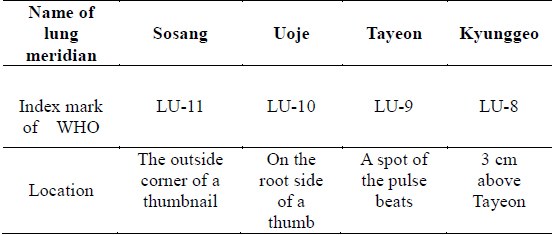
The relation of a thumb and the lung meridians
>
The method of abdominal breathing
A sound Samulnori depends on the speed rhythm and the tightness of the sphincter muscles of the anus. Samulnori should match a rhythm and abdominal breathing. Profound relaxation helps the body and feels refreshed and keep muscles feeling loose. Samulnori should be kept time with the deep breath. When you take a deep breath, your sphincter should be relaxer. When you breathe out your breath, your sphincter should be constructive. Take a big breath in, and try to hold your breath and save in your abdomen and allow your abdomen to expand on breath. As possible, tense your sphincter muscles and then relax repeatedly. At this time, breathing work should be deep, comfortable, and rhythmic and extend your back and breast. Keeping your breath fresh is important. Hold your breath for five more seconds and count to five again as you breathe out with stretching and drawing in one’s a thumb and an index finger. So it is important to make efforts to keep time with Samulnori’s rhythms. Samunori’s rhythmic patterns do, use duple division (2) and mixed division (2+3 or 3+2) beats in our class (Table 4). It is the kind of work that mind training through abdominal breathing him to be healthful significantly (Table 5). While breathing your breath, imagine that your body is filled with strong, bright energy. As we know, breathing deeply helps you feel relaxed and reduces your stress level. A good posture of Samulnori strengthens the abdomen and sphincter and promotes the action of one’s bowels, strengthening the ability of kidney and liver.
[Table 3.] The relationship of an index finger and the large intestine meridian
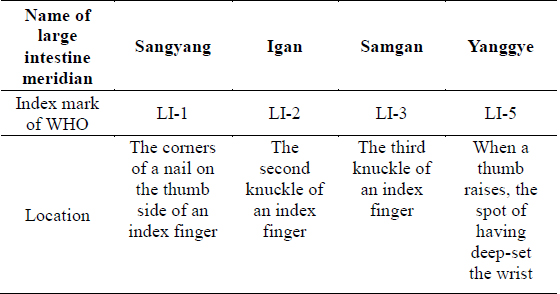
The relationship of an index finger and the large intestine meridian
[Table 4.] The methods of abdominal breathing with rhythm pattern of Samulnori

The methods of abdominal breathing with rhythm pattern of Samulnori
[Table 5.] The contents of learning Samulnori

The contents of learning Samulnori
Recent research has demonstrated the potential of meditative practices to support the goals of education such as improved attention, concentration, creativity, and emotional intelligence (Cowger and Torrance, 1982; Goleman, 1995; Mayer and Salovey, 1997; Shapiro et al., 2008, for a review of research on meditation and higher education, and increases in positive mood and immune system functioning (Davidson et al., 2003), reduced physical symptoms and stress (Grossman et al., 2004; Broderick and Metz, 2009).
With the permission of the interviewee, the interviews were tape-recorded, video-recorded, and transcribed within 3 hours to ensure a high degree of accuracy and reliability. In-depth interview in my class, lasting an average 2 hours were conducted. An interviewee was encouraged to offer his own thought and personal interpretation of his motive and practice for learning Samulnori. The questionnaire is based on interview and observation drawn from a field experience. A combination of open question was used. The majority of the questions begin with ‘when’, ‘how’, ‘what’, and ‘did’ as a reminder to keep the questions and open. Also, while talking and lessoning with him, I watched him closely.
He allows author to do whatever I like to do without worrying about.
He said, “I drew a fine picture of his future happy artist, unless you understand your true self first, you cannot influence me in a meaningful way.”
>
In-depth interview and observation
The author reports the case of 74-year-old live cirrhosis who has taken Samulnori lesson of three times a week for four years. He was attacked with a liver cancer and underwent surgery in 2003. After the cancer, he distracted himself by cultivating. But he had a recurrence of liver cirrhosis in 2009. He takes an antidote twice a day until now. He is a man of resolute will. The author asks him to join a benefit performance with playing Samulnori. He received the performance after with joy. He said, “giving a reward can help me to stay motivated and lifestyle change could be facilitated through a combination of learning and practicing experience that enhance awareness, increase motivation, and the will to live.” The author asserts, he is a living sample for how to tap into our human potential power. The following is an in-depth interview with him:
When were you born? I was born 1941 on November.
When did you attack by liver cancer? I was attacked with a liver cancer in 2003. When I was operated the cancer, I lost weight 44kg. It’s very dangerous to do anything curing, but I underwent an operation. But doctor said, ‘even if you die in the surgery, shouldn’t dies’.
How many members are in your family? There are four members in my family. I live with my wife, one son and one daughter
What was your job? At long time I owned a glass-mirror store, so I had a made a fortune through my own efforts.
Did you spend a lot of time taking to your family before cancer? Yes, we all took time to talk with each other. Especially, at meal times, we all got together to eat and talk.
Did you drink? What was your limit? I drank too much before cancer. I drank at least 10 glasses of liquor everyday mostly, so I thought heavy drinking causes harm to the liver. I was often reveling all night.
What did you usually do to get rid of your stress? I was up anyone or something. Actually, I was a lot of stress at that time. Heavy drinking was a way of releasing pent- up the oppression and stress.
What did you do rest time before cancer? I drank too much in my spare time, but I tried to go out for lunch at least once during the week to clear my head.
What kind of personality do you think you have? I am professional in my field, responsible, and a family man.
What would you say are strengths and weaknesses? I take tasks and do them until they are completely finished done well.
Actually, it’s my strength and weakness to do these things.
What is your talent? I am a man of fine feeling, my dance is pretty good. Although, I am an old, I am very likely person and smooth.
Do you drink in these days? I can’t drink a lot now, but I like the relaxed atmosphere being peoples.
How is your health now? I have been in good health. I usually play the percussion instruments, Samulnori actively. It really relaxes me.
How do you manage stress in your daily work recently? I have a personal rule that stops me from reacting to any problem until I feel calm about it. I think, then act, I learned to do that over time.
What do you think is the most important thing for you to achieve happiness in these days? The best happy thing is having good friends through learning and playing SamulNori. Moreover, I am active in a benefit performance for the aged in nursing home once a month from 2011 to 2014. After the performance by listening carefully to audiences’ thanks and blessing, I am very happy to do something now. Also, a benefit performance provides the catharsis that often the self-esteem and leads to the most worth. Although, I do a benefit performance for them, I also receive an inexpressible joy and healing from grateful the audiences. That’s can’t be calculable for money. It’s my great pleasure. I realized that small things can make other people happy also, be sound in my mind and body. A recurrence of liver cirrhosis has become a catalyst for great conscious change. I promised, healing is a believing, therefore my mind and body have unlimited influence, and the ability to effectively generate positive change.
What do you learn from the Samulnori? I learn how to express my emotions and that developing and maintaining good relationships with people is the most healthful thing. Samulnori has been my strength through difficult times. My daily life was boring and I was looking for a change in my life.
What do you think is the key of playing Samulnori that helps cure your liver cirrhosis? I was lost in thought for a long time. I may meet my end at any moment. But my wish was fulfilled. My long-cherished desire was realized. Throughout my life, I have dreamed about an artist. Had it not been for learning and practicing Samulnori and the encouragement of good people in my life, I would not be living the normal life I’ve always dreamed of. Also, after the playing Samulnori, the sweat always stood in beads upon my back and drops of sweat stood on my brow. At that time, normally, without breaking sweat, and lived and my appetite had fallen off, so I always felt very tired. However, I believe a playing Samulnori has the proper amount of exercise to get a great appetite and use similar mechanisms to help boost immune system and reduce the stress in my body. After a round of playing Samulnori, I feel refreshed and relaxed. I was very gratifying that I felt something gushing up inside me. So I always gain in strength. Also, playing Samulnori makes me happy and meaningful in my daily life. This is a cure-all for me. Moreover, the author tries to give me an opportunity express my feeling and the same consciousness, I must be implicated on nursing homes, therefore I do my best to give a hope to the aged. I think it motives me work happier and get better health.
How is your doctor? He said, “liver cirrhosis prognosis is good gradually, what do you do for your liver health?” After listening to the facts, my doctor suggests that I should also continue to learn and enjoy being health liver through playing Samulnori.
What are your feelings at the present? As people today are looking for signification and valuation in their lives, learning and playing Samulnori brought about a change in my sense of values and theory of life. I think the secret of health for both and body is not to mourn for the past, not to worry about the future, but to live the present moment expressively and positively. It is to need not magic to transform our mind and body. We carry all the power we need inside ourselves. Also, we have the healing power to cure better, as everything is up to mind. Various factors attacked me, but my indefatigable spirit is carrying from me over the liver cirrhosis.
This article presents a case study that has been conducted on the effects of learning and practicing music of Samulnori for a patient of liver cirrhosis. The author found that Samulnori can help restore self-confidence, self-control, positive attitude, and training of the mind, also just before he die, a desire to be dream come true. It could be overcoming the disease. It was just a dream for self-realization. In other words, learning and practicing, or musical experience Samulnori with abdominal breathing can influence the physical health and psychological satisfaction. Although, doctors admit they still don’t understand exactly why this mysterious healing occurs, the power between our mind and our body is mysterious that science can’t capture. The author acknowledges that scientists will try to find the factors of curing through learning and practicing Samulnori. The author also believes that the patient achieved inner peace by relaxing the body and mind and relieving stress through abdominal breathing.
Buddha said, “Our life is a creation of our mind.” Also, there is a proverb in Korea that says, ‘everything is up to one’s mind.’ That is to say, our body and mind have an effect of psychological, sociocultural factors and universality and also, the most important thing in health is that the mind and body come to communicate each other. Health could also be considered as an ideal state, as mental and physical fitness, as commodity or as a personal streghth (Kaur and Shinha, 2013; Tassinari and Roberti, 2014). The rhythm of Samulnori is the ‘feelgood factor’ of the Korean people embodying their characteristics and emotional genius. It is also a way of releasing pent-up frustration and stress while beating time with the bamboo mallets. Through abdominal breathing, he gets the peace of mind, psychological satisfaction and self-confidence.
Also, Samulnori is nature-friendly music that gives one an opportunity to rest and reflect upon oneself. After playing Samulnori, the sweat stood in beads upon one’s the whole body. Not till then take place an immersion and concentration to be sound in one’s mind and body.
As psychiatrist Torrey stated, psychiatry is becoming an exceedingly dispensable profession, as nonmedical practitioners have been helping people solve problems of unwanted human behavior and have been doing a good job (Torrey, 1974; Cay, 1976). Alternative cure can sometimes provide a cure where conventional medicine cannot. Health care professionals are beginning to treat not only the patient’s medical condition or diagnosis, but the patient’s state of mind as well (Judith et al., 2010). Also, understanding preserved capacities should facilitate efforts to use music successfully in intervention programs and programs directed at fostering new learning (Cuddy et al., 2012). Thus, the author believes that even an hour of enjoyable and invaluable time can benefit a patient in controlling and ultimately winning over one’s stress and finally overcoming one’s disease.
1. The author applies a new process of ‘Gukak chiryo (a kind of Korean traditional art therapy)’in liver cirrhosis, and may seem similar to the issue of ‘music therapy’. However, Samulnori is not just expression to describe certain music rhythms, because Samulnori includes integrated art that consider life from a philosophical and psychological point of view through yin/yang and Five-element principles. 2. According to an OECD, South Korea ranked lowest among OECD member states in terms of the practicing physician density 2.6 peoples per 1,000 populations.
